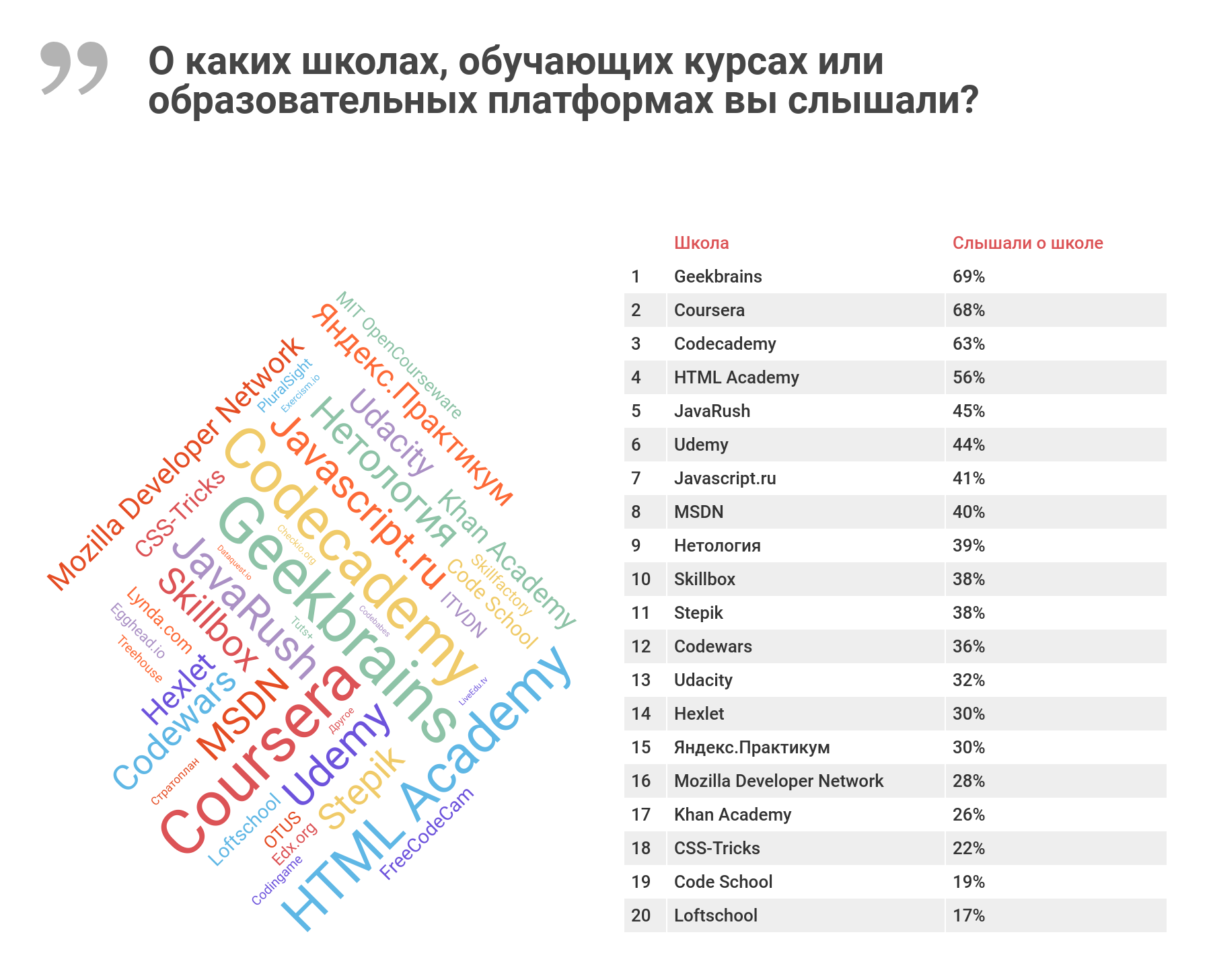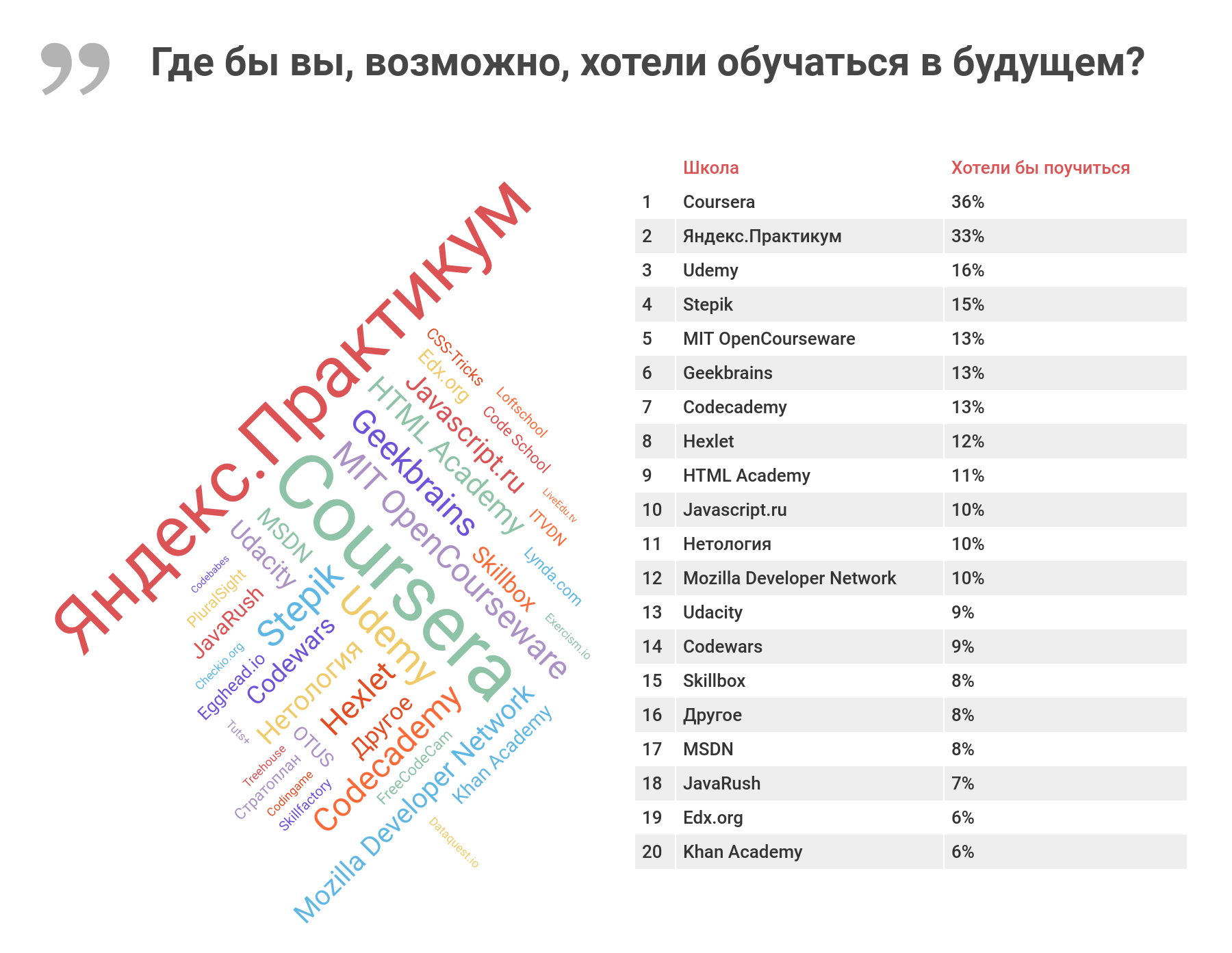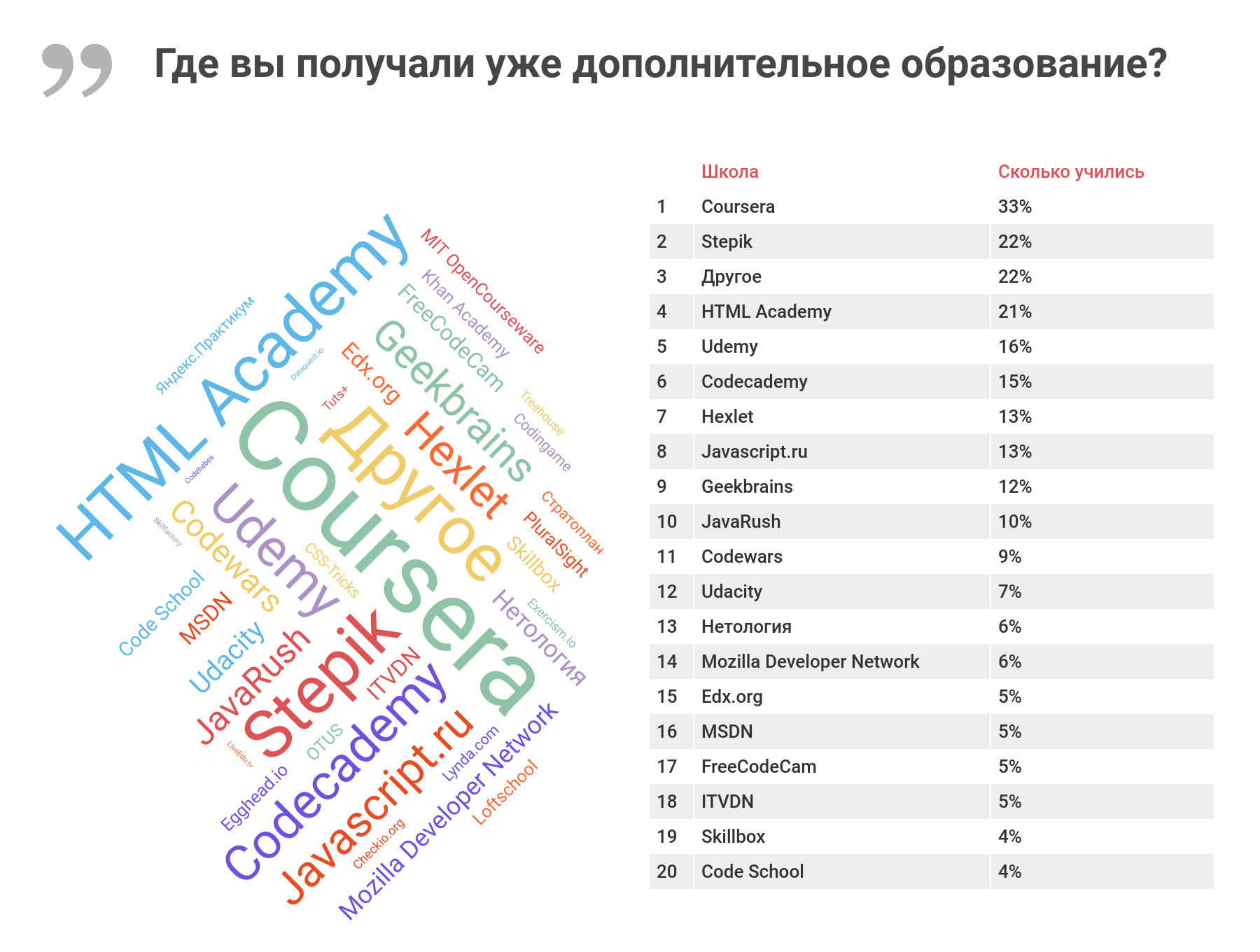Rating sites additional education in IT: the results of the study "My Circle"

We continue to publish the results of our research about education in IT. In the first part, we dealt with education in general: how it affects employment and career, in which areas specialists receive additional education and what motives they are guided by, how much the employer contributes to such education of their employees.
We found out that the most popular form of additional education — after self-education with the help of books, videos, and blogs — are courses: 64% of specialists practice this format. In the second part of the study, we will deal with existing schools in the domestic market of additional education, find out the most popular ones, what exactly they give to their graduates, and build their rating.
')
We hope our research will tell experts where to go to study, and schools will help them understand their current strengths and weaknesses and become better.
1. What schools are most aware of
In the survey, we offered a choice among 40 schools of additional education in IT: which of them heard, which ones you would like to learn, and which ones you studied.
One fifth of all respondents know more than half of the list of schools proposed for voting. More than half of respondents heard about such schools as Geekbrains (69%), Coursera (68%), Codecademy (64%), HTML Academy (56%).

As for the choice of a site for their future education, there are no obvious leaders here: only a third of the sites received more than 10% of the votes, the rest less. The majority of the votes were collected by Coursera (36%) and Yandex.Practicum (33%), the rest - each less than 20%.

In response to the question about the sites where education was already received, the votes were even more diverse: only a quarter of the sites received 10% or more. The leaders were Coursera (33%), Stepik (22%) and HTML Academy (21%). “Other” accounted for 22% - these are all sites that were not on our list. The remaining sites scored - each less than 20%.

We carried out all subsequent calculations only for those schools that were the only ones who had completed the courses in their experience and for which there were 10 or more opinions. This was done because in order to have an unambiguous connection between the school chosen by the respondent and the other parameters he chose elsewhere in the survey. As a result, out of 40 schools, we have 17 left. As we saw in the first part of the study, almost half of the respondents said that they attended only one school.
2. Goals that schools help to achieve
In the first part of the study, we saw that most often receive additional education for general development - 63%, solving current problems - 47%, and receiving a new profession - 40%. There we also saw how the balance of goals differs, depending on the higher education or current specialization.
Now we will look at the learning objectives in the context of specific schools.
If you look at the table in rows, we see what the structure of goals for students of each school. For example, in Hexlet they go mainly to get a new profession (71%), general development (42%) and change in the sphere of activity (38%). With similar goals also go to: HTML Academy, JavaRush, Loftschool, OTUS.
If you look at the table in columns, you can compare schools with each other by the goals that students believe they can achieve in them. For example, work on promotion at work most often in MSDN, Stepik and Coursera (35-38%); change a field of activity - in Hexlet, JavaRush and Skillbox (32-38%).

3. Specializations that schools help to master
Further, we will combine the respondent’s current specialization with the school where he studied.
Looking at the table in rows, we will see the structure of the demand for the school by specialists from different fields of activity. Schools demanded by specialists from the largest number of professions are: Coursera, Stepik and Udemy - which is logical, because they are more like platforms on which the authors themselves can post their courses. But such schools as Netology with Geekbrains, in which courses are added by the organizers themselves, closely adjoin them. And the schools demanded by specialists from the smallest number of professions are: Loftschool, OTUS and JavaScript.ru.
Looking at the table vertically, you can compare schools by their depth of demand from those or other specializations. For example, Loftschool (73%) and HTML Academy (55%) are more popular with front-end vendors, Stratoplan (54%) are for managers, Skillbox (42%) for designers, MSDN (31-33%) for admins. , testers have JavaRush and Stepik (20-21%)

4. Qualifications that schools help to receive
In the first part of the study, we saw that, in general, in 60% of cases, educational courses do not provide any new qualifications, then most of all are juna (18%), interns (10%) and middles (7%). In the same place, we saw that in this case the ratio of the qualifications obtained depends on the field of activity of the specialist.
Now we will look at the same question in a section of concrete schools studied by us.
If you look in rows, we see that such schools as Coursera, Udemy and Stepik (69-79% of graduates indicated that they did not acquire qualifications) give the most rare courses - these are platforms for adding author's courses of the widest orientation. The Specialist also closely adjoins them (74%). And most often, new qualifications are given by such schools as Hexlet, OTUS, Loftschool and JavaRush (25-39% of graduates indicated that they did not acquire qualifications).
If you look at the columns, you will notice that Skillbox, Hexlet, JavaRush, Loftschool and HTML Academy are more focused on training junas (27-32%), OTUS - on preparing middles (40%), Stratoplan - on training top managers. link (15%).

5. Criteria for choosing schools
From the first part of the study, we know that the most important criteria by which courses are chosen is the training program (74% noted this criterion) and the format of training (54%).
Now let's see how these criteria differ when choosing a school.
Note only the brightest points of the table, everyone can see the rest on their own. So, obtaining a certificate is extremely important when choosing a Specialist and MSDN (50% of graduates called this criterion). The teaching staff play a huge role in OTUS (67%) - this criterion for this school is generally the most important. According to reviews on the Internet choose such schools as Hexlet and Loftschool (62% and 70% respectively). For Loftschool, the cost of education is also very significant (70%).

As you can see, the schools of additional education are very different from each other: in their specialization, qualifications issued, goals achieved, the criteria for their choice. As a result, at the moment there is no school that would be the definitive leader in the additional education market.
Nevertheless, we will try to build a rating of schools further, based on the indirect data that we obtained in our survey.
6. Rating of schools of additional education
We proceed from the fact that educational courses should solve the purely practical tasks of their graduates, namely:
- The school should give the necessary experience (let's call it “real knowledge” and give this criterion weight 4) and help with direct employment (let's call it “real help” and give weight 3).
- In addition, it would be nice for the school to issue a certificate that is recognized by the employer, as well as to give work in the portfolio (let's call it all “indirect help” and give weight 3).
As a result, if every graduate says that the school gave him the necessary experience (4), helped with employment (+3), and also gave work in a portfolio and a good certificate that helped in employment and career (+3), then the school will receive maximum rating 10.
To begin with, we will calculate the indirect assistance that schools provide with their certificates and works in the alumni portfolio. Survey data is highlighted in red columns: what percentage of graduates noted this school quality, and our calculations for violet.

At first we consider the average help of the certificate as the arithmetic average of its help with employment and career. We get that, for example, Loftschool certificate helps 27% of graduates, and the Codeacademy certificate - only 5%.
Next, we calculate the average indirect assistance of the school as the arithmetic average of the certificate and assistance in the portfolio. We get that, for example, Hexlet is not very good with certificates (8%), but it is the steeper with the works in the portfolio (46%). As a result, their average is good, although not the biggest - 27%.
Next, let's combine all our three main criteria, calculate the total score and sort by it: here is our final rating!

An example of calculating the total score for Loftschool: 0.73 x 4 + 0.18 x 3 + 0.32 x 3 = 4.41.
This rating is based on indirect data from our survey. We did not ask respondents directly about each of the schools. In addition, the number of opinions taken into account for each school is different: someone has only 10, and someone has more than 100. Therefore, the rating we have built is more of a test experimental character and reflects only the most general laws. Over time, we will begin to build it on “My Circle” on a regular basis, adding to the school pages the ability to evaluate them according to several criteria, and we will get a more objective picture. How to do it already for companies-employers .
And now we offer everyone who has completed additional education courses to visit My Circle and add them in their profile: so that you can see interesting statistics on graduates. Profiles of the top 5 schools on My Circle: LoftScool , Hexlet , OTUS , HTML Academy , Specialist .
PS Who participated in the survey
3700 people took part in the survey:
- 87% of men, 13% of women, the average age is 27 years, half of respondents aged from 23 to 30 years.
- 26% from Moscow, 13% from St. Petersburg, 20% from million-plus cities, 29% from other cities of Russia.
- 67% are developers, 8% are system administrators, 5% are testers, 4% are managers, 4% are analysts, 3% are designers.
- 35% of secondary specialists (middle), 17% of junior specialists (junior), 17% of senior specialists (senior), 12% of leading specialists (lead), 7% of students, 4% of trainees, middle and senior managers.
- 42% work in a small private company, 34% in a large private company, 6% in a state-owned company, 6% freelancers, 2% have their own business, 10% do not work temporarily.
Source: https://habr.com/ru/post/454906/
All Articles